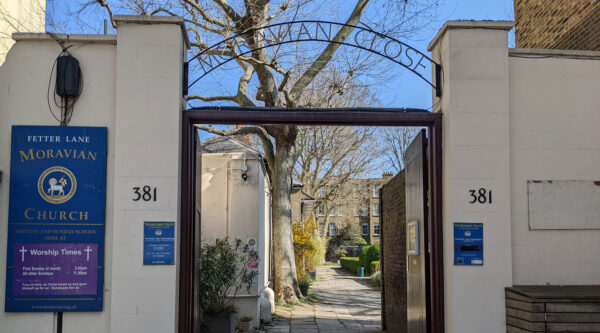Not easy to find in Chelsea as it’s hidden behind high Tudor brick walls is an unusual burial ground – for the Moravian Church, and unlike most Christian burial grounds, here the graves are all the same with small stone plaques laid out in regimental order.
The Moravian Church is one of the oldest Protestant denominations in Christianity, dating back to the Bohemian Reformation of the 15th century, which saw movements against several practices and doctrines of the Catholic Church. The Moravian Church came to England in the early eighteenth century, initially at Fetter Lane in the City of London, and was later recognised by Act of Parliament (Acta Fratrum 1749) as an ancient Protestant Episcopal Church.
In 1750, Nicolaus Ludwig, Count von Zinzendorf, who in addition to being a German nobleman was a Bishop of the Moravian Church, bought an estate in Chelsea for the church. He planned to build a housing development on the site for the church, but that never happened. What was built though, first of course, was the chapel and burial ground for the planned housing development, and that’s what survives here today.
The Fetter Lane church was destroyed in 1941 during a WW2 bombing raid, so the congregation moved to Muswell Hill, but still meets at its Chelsea home as well, and that’s why this site in Chelsea is called Fetter Lane Moravian Church.
Entry is through a couple of large gates in the wall, helpfully advertised by a sign that this is the Fetter Lane Moravian Church.
A series of high walls surround the burial ground, in part dating back to Tudor times when this was part of Sir Thomas More’s estate, and the burial ground is likely to be on his old stables until King Henry VIII decided he had enough of his minister and swiped the land, and well as his head. According to a sign by the entrance, the burial site is the largest Moravian burial site in England and Ireland, and is unique in being the only remaining intramural burial ground in London, after the rest were banned in the 1850s.
In a peculiar way, the grounds look not unlike a bowling green, having a large square lawn and a pavilion-style building at one end and covered seating at the other.
Of course, it’s a burial ground, as indicated by the long regular lines of gravestones in the ground. In Moravian Church traditions, each gravestone is identical in style to hundreds of others irrespective of the gender or former status of the person buried there. Equality in death, if not necessarily in life. Some of the congregation’s early leaders including Peter Böhler, John Cennick, and James Hutton were laid to rest here.
At the far end of the burial ground is a large bench backed by heraldic shields of the former owners of the land around here.
Had you been here in the 1970s, you might have been a bit surprised though to see a live lion roaming the graveyard.
In 1969, rather famously, two men, John Rendall and Anthony “Ace” Bourke bought a lion from Harrods, named him Christian, and needing somewhere for exercise, were allowed to bring him to the graveyard for walkies until he was reintroduced to the wild in 1971.
For a while, a Christian lion wandered the Christian graves.
These days, the worshipers refer to the burial ground as Gods Acre, which has a rather nice ring to it, and it’s certainly a peaceful escape from the bustle of posh Chelsea beyond the walls.













I thought the ban was just for burials within the city. We have a walled burial ground at Wandsworth Friends Meeting and were interring well after the 1850s. There’s also a walled Jewish burial ground in Chelsea that must be 19th Century. It’s visible from the top of the 14 Bus.
please could you give the address? Is it 381 King’s Road? I don’t see a 1 on the map